Newcastle Bicycle Carnival, March 1897
This month’s photo was taken 125 years ago in March 1897. So much has changed that it’s hard to recognise the location today. The photo was taken from the brewery buildings in Hamilton East (now part of Hamilton TAFE) looking towards Bar Beach. In the foreground is a Rugby Union ground, and behind it to the right is Newcastle’s original racecourse, before the Broadmeadow racecourse opened in 1907.
In the background, below Shepherds Hill there is a line of coal wagons at the “Sea Pit” of the A. A. Company, and in the foreground the railway to their “D Pit” in Hamilton. All the land in this photo belonged to the company, part of 2000 acres granted by the Government in 1830. When finished with coal the company turned to real estate and subdivided the land in 1913. Stewart Ave now runs through the former rugby ground.
Although the scene has changed, the subject remains.
Ralph Snowball photographed a bicycle carnival, a two-day event of races on a banked velodrome track built around the rugby field. The 1890s was a decade of huge popularity for cycling, with the Newcastle Morning Herald having a weekly column “Hums of the Wheel” reporting on the sport. The first column in March 1892 noted that “since the advent of the safety bicycle, cycling has received an impetus which has placed it on a par with any other sport in the world.” Unlike the earlier ‘penny farthings’ where the rider perched precariously above a large wheel, safety bicycles had equal sized wheels, propelled by pedals and a chain, with the rider seated low to the ground. By end of 1890s interest in cycling had waned significantly, and at a charity event hoping to draw a crowd of thousands, just 60 turned up. The downturn however was only temporary, and cycling has ever been on an upward trend. Its popularity now so great that an astonishing 1.7 million bicycles were imported into Australia last financial year.

The article above was first published in the March 2022 edition of The Local.
The Bicycle
Prior to 1876, the standard or “ordinary” bicycle had two different sized wheels, with the rider seated high above the larger wheel at the front, propelling it with direct pedal action.

In 1876, J H Lawson of Brighton UK, invented the “safety bicycle”.
The special feature of this machine is that the rider sits over the smaller wheel and as the big driving-wheel at his back; the feet are thus always within easy reach of the ground, and the danger of falling is reduced to a minimum.
“The Rainfall”, 9 December 1878
Within a short period of time the design of the safety bicycle had evolved to having two equal sized wheels, with the rear wheel driven by a pedals and a chain. In 1879, the cycle manufacturer George Singer started making safety bicycles under license from J H Lawson. Initial uptake was slow and …
“… it was not until 1885 that the safety bicycle was fairly established in public favour.”
The Riverina Grazier, 1 SePtember 1896
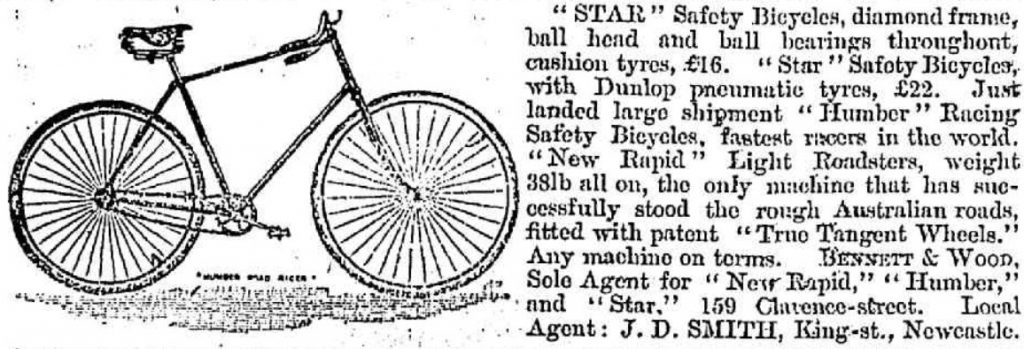
The Bicycle Carnival
The Bicycle Carnival in March 1897 was held over two days, Thursday 25 March and Saturday 27 March. It would appear that Ralph Snowball has made a minor error in annotating his negative with the date 28 March 1897.
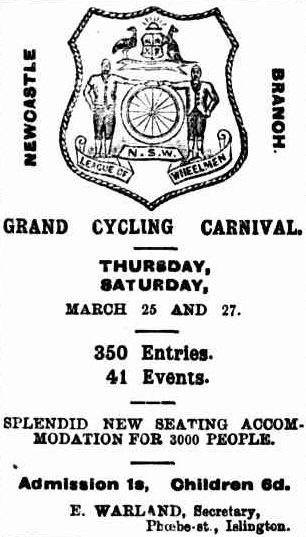
The bicycle carnival was a huge event. The Newcastle Morning Herald reported on the following Monday 29 March 1897 that “there must have been nearly 6000 persons present, comprising visitors from all parts of the country, and especially from the metropolis.” Special tram services were arranged to get patrons to and from the event, and proceedings were attended by representatives from eight different newspapers.
One more thing to ponder about Snowball’s photograph – if the subject is a bicycle carnival, where are the bicycles? With the glass plate negative cameras that Snowball worked with, the exposure time meant that any cyclists on the track would be but a blur. One cyclist can just be made out at the left of the photo.

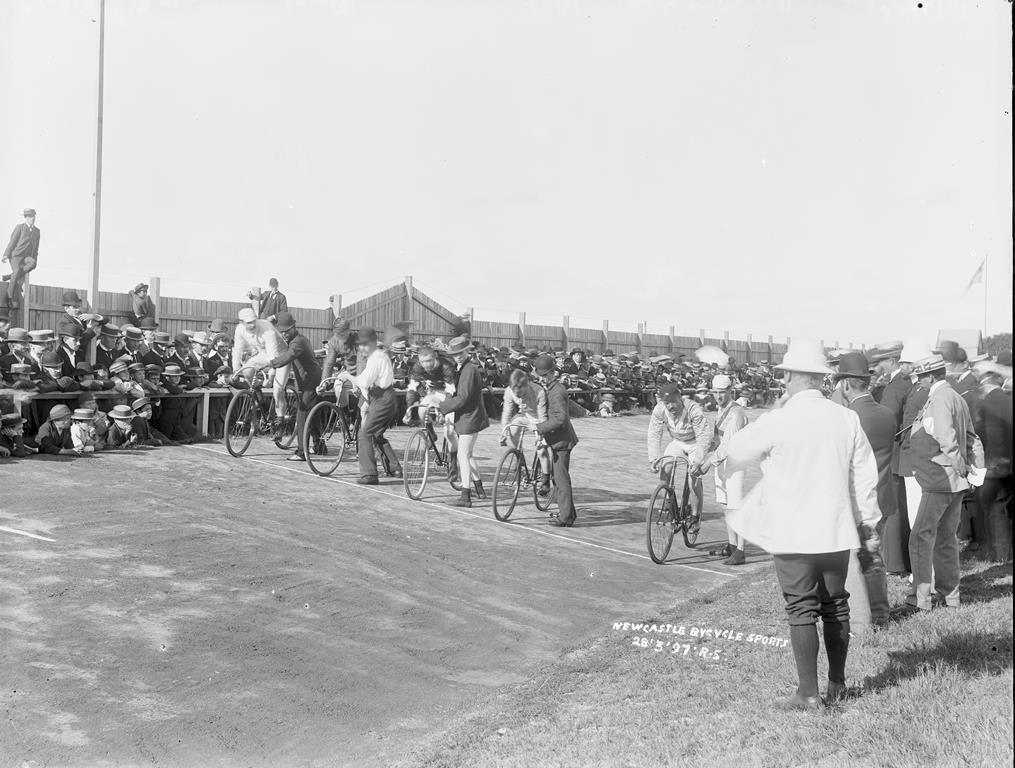
Location of the Bicycle Carnival
A brief mention of the bicycle carnival in the newspaper on 29 March 1897 reports that it was held on the Rugby Football Ground.

The Rugby Football ground can also be seen in a 1906 Ralph Snowball photograph, which is part of a 4 panel panorama taken from the Obelisk hill. The brewery building from which Snowball almost certainly took the photograph is at the right of the ground, with the A. A. Company coal rail line running between.
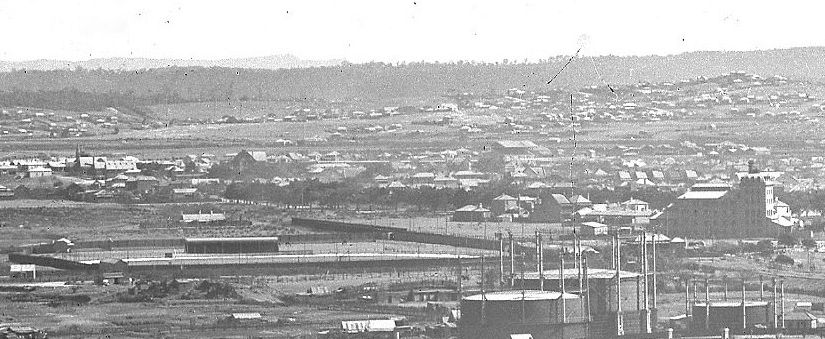
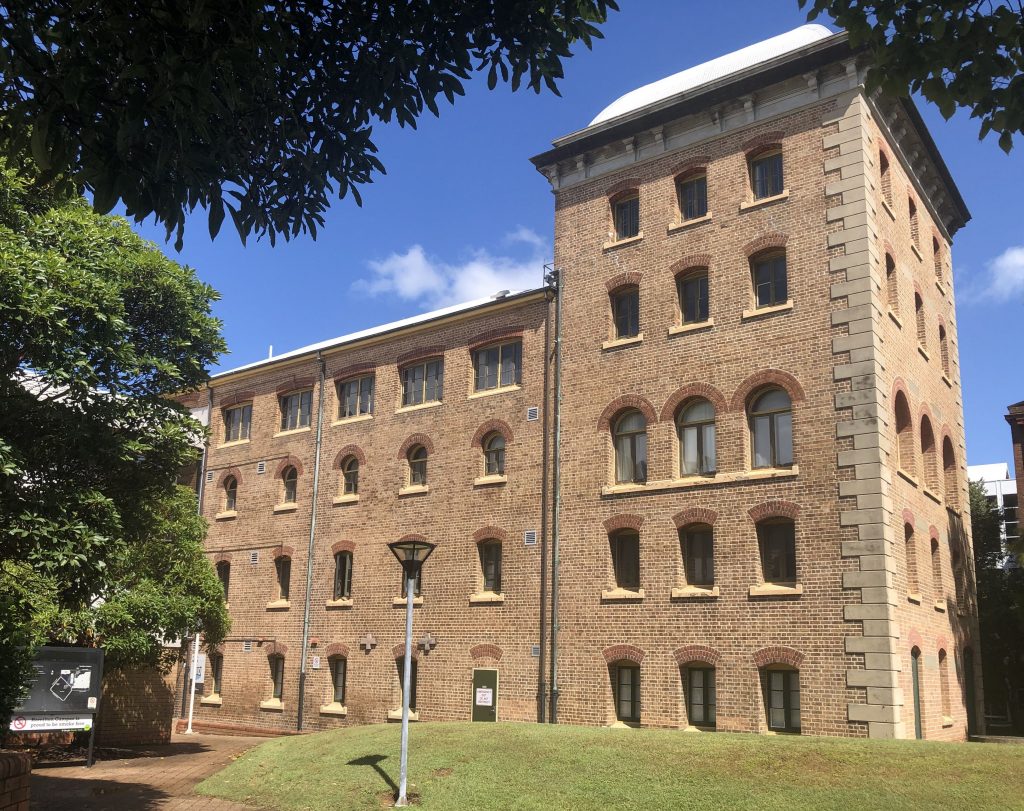
Australian Agricultural Company land and the “Garden Suburb”
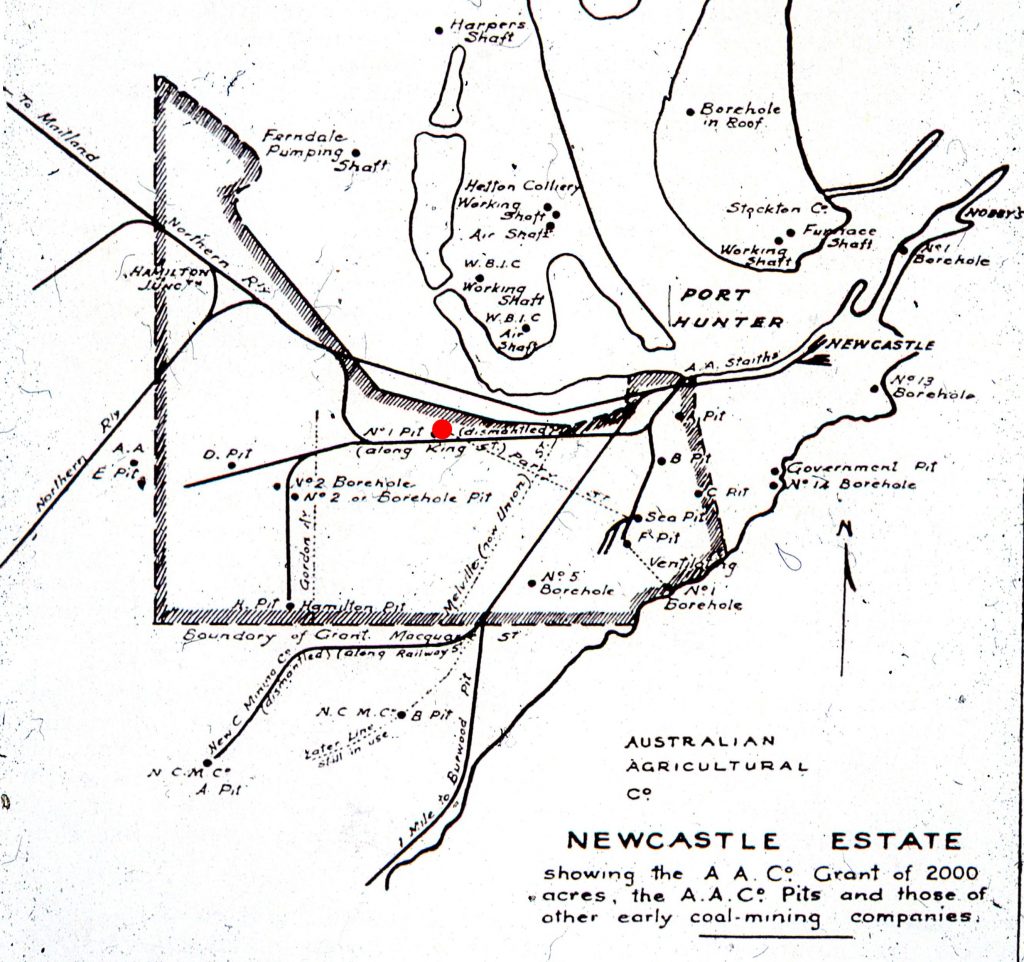
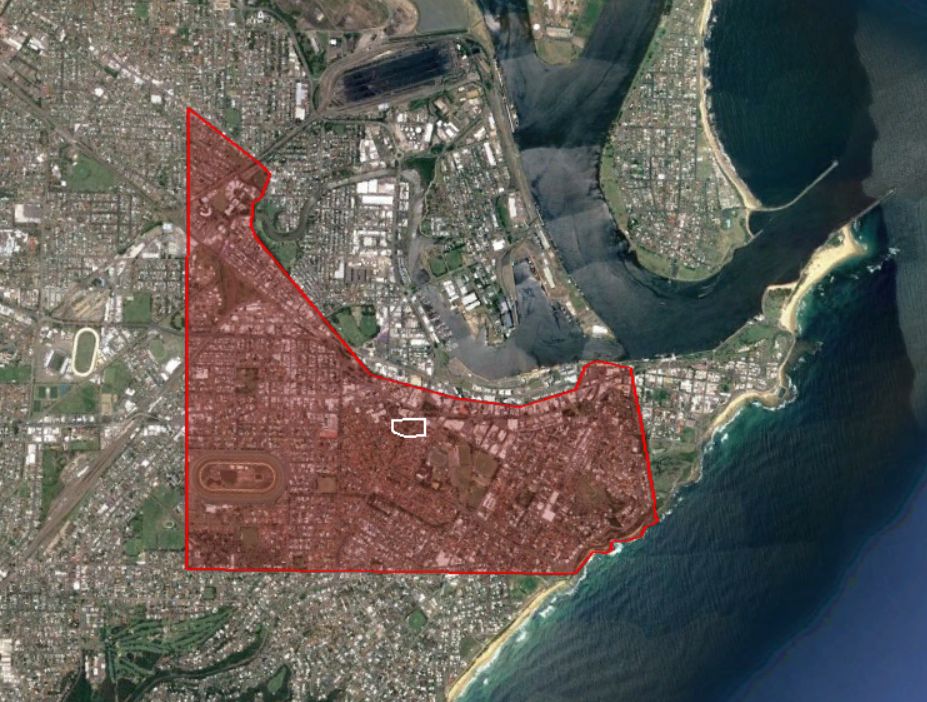

In 1913 the A. A. Company announced a grand plan to develop their land into an attractive “model suburb”.
A MODEL SUBURB. A.A. COMPANY’S INTENTIONS.
Newcastle Morning Herald and Miners’ Advocate, 28 April 1913.
The first attempt at a practical application of the principles of modern town planning in the vicinity of Newcastle is about to be made by the Australian Agricultural Company, the scheme being yet another indication of the company’s enterprise in the direction of advancing the interests of the city and district. The proposal is to set apart a portion, of the company’s estate, consisting of about 250 acres, and lying west and south-west of Melville [now Union St] and Parry streets, for the purposes of a model suburb, and the requisite plans for the undertaking have already been completed. The design has been worked out by Messrs. John Sulman and John F. Hennessy, of Sydney, and every endeavour has been made to embody in it all the features which experience in other parts of the world has shown to be most desirable … Fine wide streets, planted with trees in such a way as to be ornamental in fact as well as in name, are naturally looked for in a model residential area, and they will not be looked for in vain in the A.A. Company’s so-far-unnamed suburb.
The following year, in May 1914, the company advertised the first subdivision in their new suburb, promoting it as the “Garden Suburb”.
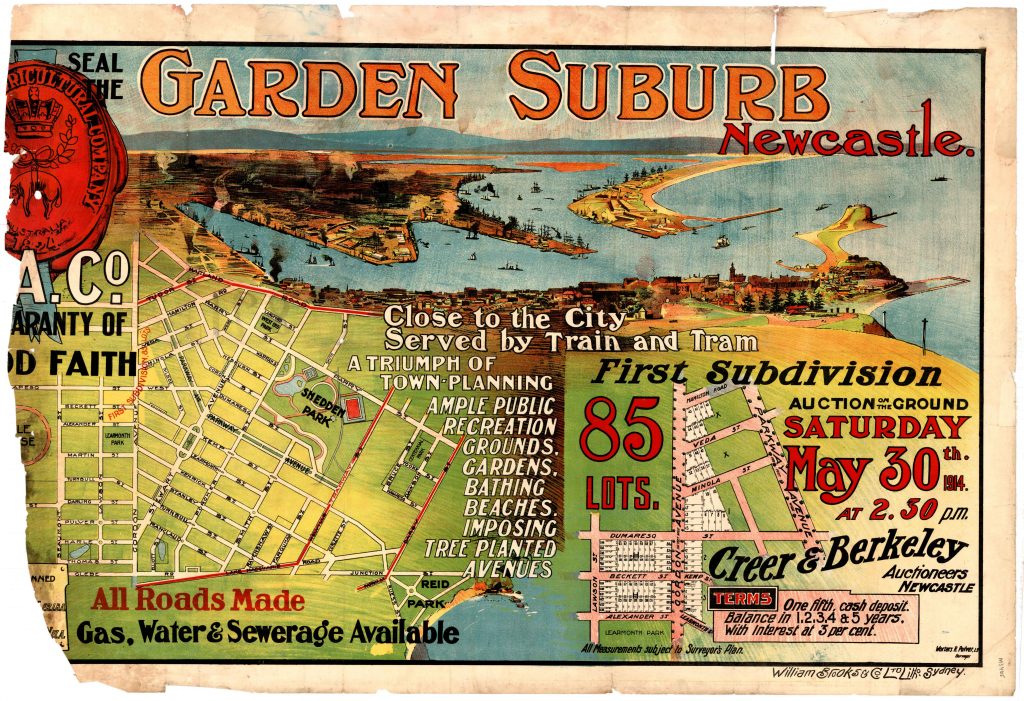
The name “Garden Suburb” was a marketing phrase and not the official name of the suburb, although it did make its way onto the plaques on the commemorative columns at Learmonth Park.
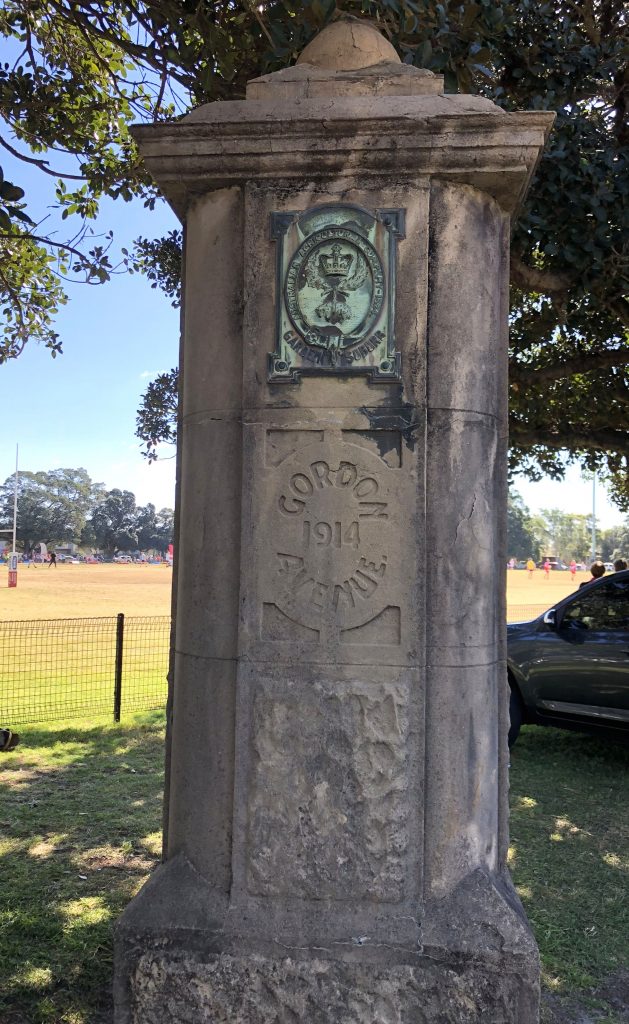
One interesting feature of the original 1913 design of the suburb that never eventuated, was an ornamental garden and recreation area in the middle of Stewart Ave.
About half-way along Stewart avenue a large oblong-shaped space is to be utilised for enclosed grass plots, and in the centre of it a band-stand will be placed. There probably will be two of these turfed squares, and at each end of these will be a semi-circular plot, one having an ornamental fountain within it, and the other a piece of statuary.
Newcastle Morning Herald and Miners’ Advocate, 28 April 1913.
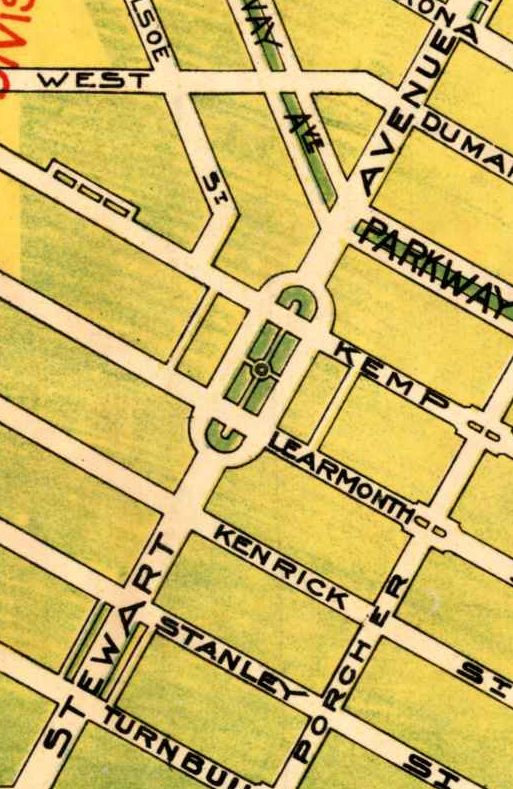
Note that the modern suburb named “Garden Suburb” dates back to 1918, when the Assurance and Thrift Association Ltd developed a subdivision in the Cardiff area.
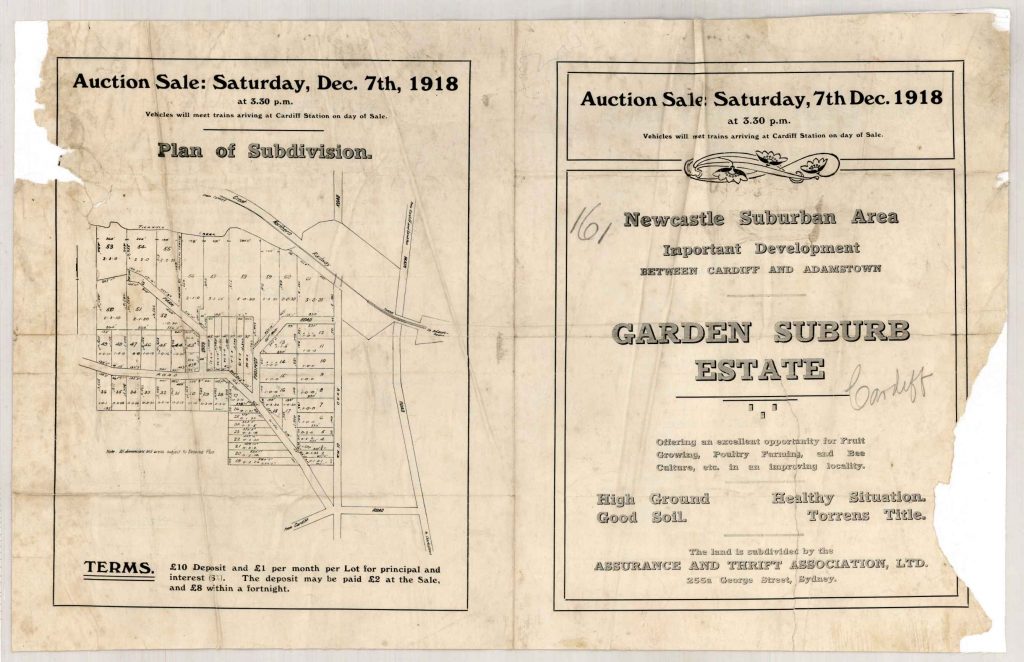
Newspaper articles
| Article Date Event Date | Notes |
|---|---|
| 9 Dec 1878 | Article with some details about the invention of the safety bicycle by Mr Lawson ... "The great advantage of these safety bicycles is that you can mount by throwing your leg over—as over a pony—and start instantly ; you can then go as slowly and steadily as you like, even in the most crowded thoroughfares, where high bicyclists must dismount." |
| 1 Apr 1882 | Earliest advertisement (in Trove) for a safety bicycle for sale in Australia. |
| 28 Jul 1886 | Earliest mention of a safety bicycle in the Newcastle Morning Herald and Miners' Advocate. Program for upcoming Newcastle Bicycle Club race day includes a "One Mile Safety Bicycle Handicap." |
| 19 Mar 1892 | First "Hums of the Wheel" column in the Newcastle Morning Herald and Miners' Advocate. "Since the advent of the safety bicycle, cycling has received an impetus which has placed it on a par with any other sport in the world. The introduction of the cushion, pneumatic, and other tyres of the kind to the safety has completely outstride the old-fashioned ordinary, and it is to be relegated to a back seat. Although the ordinary bicycle has been tried with the pneumatic tyres, it has not proved anything near so fast as its dwarfed brother." |
| 8 Dec 1892 | Advertisement for "Star", "Humber", and "New Rapid" safety bicycles. |
| 1 Sep 1896 | Interview with the H J Lawson, the inventor of the safety bicycle. "In 1879 Mr. Singer, the well-known maker, sent for me and offered to manufacture my cycle for the market, paying me a royalty of £2 on each machine. Somehow the innovation did not meet with popularity at this time, and it was not until 1885 that the safety bicycle was fairly established in public favor. By this time, though, I had relinquished my patents, so that I have never reaped any pecuniary profit from my invention." |
| 22 Mar 1897 | Advertisement for "GRAND CYCLING CARNIVAL. THURSDAY, SATURDAY, MARCH 25 AND 27. 350 Entries. 41 Events. SPLENDID NEW SEATING ACCOMMODATION FOR 3000 PEOPLE." |
| 29 Mar 1897 27 Mar 1897 | "Between 5000 and 6000 persons attended the bicycle sports on the Rugby Football Ground on Saturday. The weather was all that could be desired, and the sport was of a most interesting character." |
| 29 Mar 1897 27 Mar 1897 | Report on day 2 of the bicycle carnival. |
| 23 Dec 1899 16 Dec 1899 | Final "Hums of the Wheel" column in the Newcastle Morning Herald and Miners' Advocate. "The result of last Saturday's carnival should be sufficient to deter the cycling clubs from running another for some time to come. The sport is as flat as it can possibly be, and the public require something more novel to attract them. It was thought that the cause would have been in itself sufficient to draw a gate of at least a couple of thousand, but the total of sixty reflected anything but credit upon the sport-loving public of Newcastle. The Benevolent So ciety will not benefit to the extent of a copper, but on the contrary the Federal Bicycle Club will have to make good the loss over the meeting. The cycling authorities must therefore abide by the will of the public, and unless some extra attractiveness is introduced the less meetings held the better for the clubs' coffers. The racing was fairly good, but there was a sameness about the whole affair that became monotonous." |
| 18 Feb 1907 16 Feb 1902 | "Saturday last witnessed the final day's racing on the Newcastle Jockey Club's course at Hamilton, as the club's next fixture will be decided on the new course at Broadmeadow in April. In bidding adieu to the old site the president and several members of the committee grew reminiscent, and compared the condition of the course at the present time with what it was when taken over by the club. Then it was a mere waste of marsh and brushwood, but during the club's possession it had been drained and wonderfully improved, so that its subsequent conversion into a golf links for the local club became a comparatively easy matter." |
| 29 Apr 1907 27 Apr 1907 | Official opening of the Newcastle Jockey Club's new racecourse at Broadmeadow. |
| 28 Apr 1913 | The Australian Agricultural Company announces its plan to create a new "garden suburb" in an area of 250 acres to the south of Parry Street. |
